Sajek needs more than just tourism
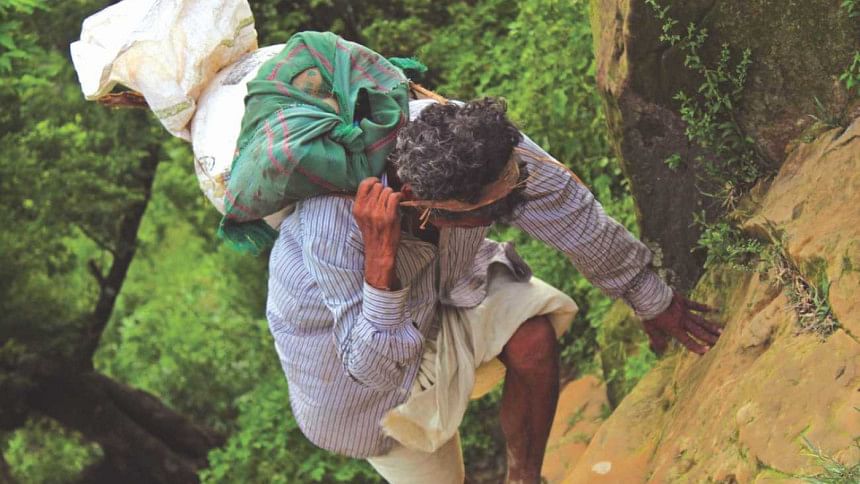
Rangamati's Sajek Union has long had a strong appeal to tourists for its pristine natural beauty and indigenous population, but now the union is appealing for help.
Scenic Sajek, the remotest union of Bangladesh in the Chittagong Hill Tracts (CHT), is undergoing a severe food crisis. This has been attributed to low yield from jhum (slash and burn) cultivation, practiced by the indigenous people living in this mountainous area, and a drop in their purchasing power. With the price of rice—a staple—shooting up to over a hundred taka per kilogram, around 2500 people of Sajek are struggling to survive.
Ensuring food security has been one of the major goals of Bangladesh since its independence. With rapid economic growth in recent years, Bangladesh has made significant strides in improving its cropping practices with a view of fulfilling the dietary needs of its huge population. However, the Chittagong Hill Tracts region is still ridden by acute food crises, and remote Sajek is failing to feed its residents.
“We are barely staying alive eating wild plants from the mountains,” says Monu Ram, who had walked for over a day from his village to come to Sajek's Ruilui para to collect relief being distributed by several organisations including nearby union parishads, timber business owners' association, jute business owners' association and student volunteers.
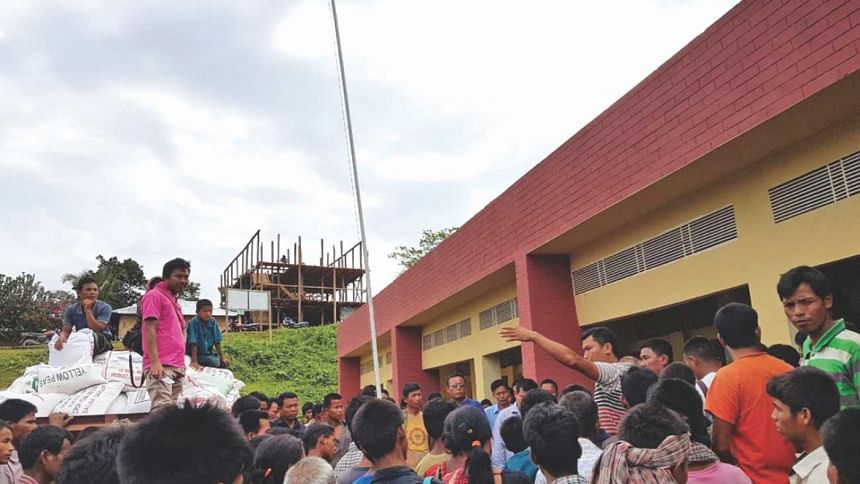
While food crisis is not new to the CHT with similar incidents in several upazilas of Rangamati, and Thanchi and Ruma upazilas of Bandarban in the recent past, the situation has exacerbated dramatically since May this year, with many jhum farmer families resorting to eating the grains they had stored for cultivation and being forced to abandon their homelands due to starvation.
Nelson Chakma, chairman of Sajek Union Parishad, told The Daily Star in an earlier interview that around 40 villages in Sajek are in need of emergency relief.
“I have already informed the upazila administration and even sent a letter to the ministry (Disaster Management and Relief) to allocate 600 tonnes food for the union,” he had said.
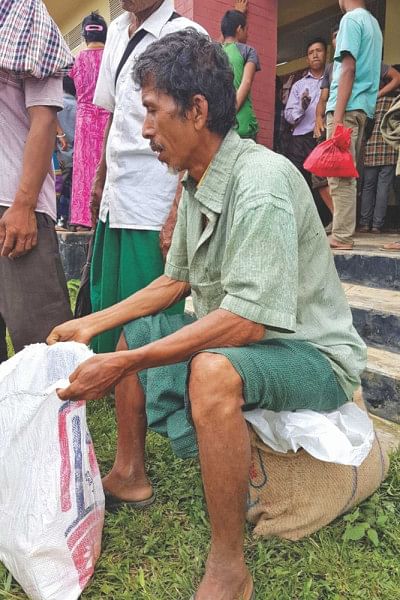
Land scarcity
Increasing pressures on cultivable land over the past few decades have forced jhumias (jhum cultivators) to reduce the fallow period from around 10 to 20 years to a mere 3 to 5 years on average today, which has drastically affected soil fertility and jhum productivity.
“Jhum cultivation was sufficient for adivasis in the past, and only oil and salt were what they needed to buy,” says Muktasree Chakma Sathi, a resident of Rangamati and founder of the voluntary organisation, Supporting People and Rebuilding Communities. “Each family used to cultivate one mountain per year, and let the soil rest for two years, but now due to land scarcity they are having to use the land more frequently,” she adds.
To understand this scarcity of ploughable land, it is important to highlight the historical context of CHT. In the 1980s, around 400,000 Bengali settlers were brought into the hill tracts region by the government with promise of Khas land. However, much of this Khas land was the indigenous peoples' traditional jhum and forestland, which they consider as common property.
“Although administratively Sajek is a union, a distinguishing feature of Sajek is that a majority of it is included within a reserved forest, which means land rights of the indigenous residents of this area are not considered,” explains Raja Devasish Roy, member of the United Nations Permanent Forum on Indigenous Issues and titular king of the Chakma circle.
Moreover, only about 3.1 percent of the land in the hill tracts is actually cultivable, with fringe land cultivation only possible for a few months a year, which means many Bengali settlers did not get the quantity of cultivable land they were promised, and indigenous people saw their lands shrinking. To make matters worse, construction of the Kaptai Dam submerged over 50 percent (54,000 acres) of the best arable land of the Chittagong Hill Tracts.
The result has been multiple rounds of cultivation over a very short period, which, combined with the inability of poverty-stricken locals to buy fertilizers, has left the soil bereft of nutrients.
“There is no moisture in the soil, we tried sowing bananas, turmeric... nothing grows anymore,” laments Journan Jhiri, a jhumia of Sajek and a mother of two, who is now trying to sell manual labour to keep her family afloat.
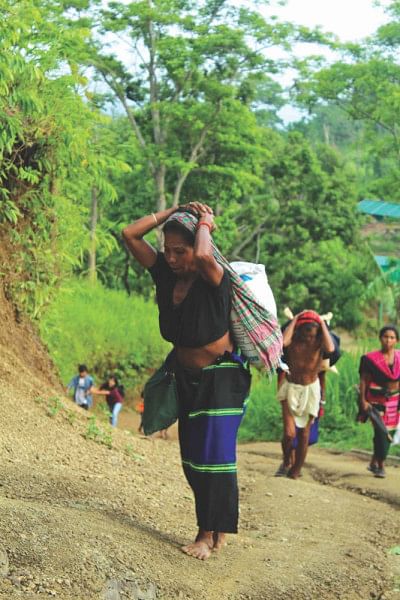
Disappearing forests
The natural forests act as sources of water and food for the indigenous people living in Sajek as well as the rest of the hill tracts, and rivers such as Shangkha (Sangu) of CHT rely on springs originating from the forests. They also help communities survive famine by providing various food sources. However, in recent years, the forests all around CHT have been dwindling.
“The indigenous people collect a lot of items for their diet from the forest, but as more and more forests are being cut down, their customary food collection system is being destroyed,” informs Shapan Adnan, Associate, Contemporary South Asian Studies Programme, Oxford University.
A plethora of factors are contributing to the disappearance of the forests including population increase, land grabbing, illegal felling, commercial crop plantation and increased use of cash crops, army camp expansion and mushrooming of tourist resorts.
While jhum cultivation has been blamed for dwindling forests in the CHT, many locals disagree.
“Many businesses clear lands for plantations, and blame it on jhum,” says Madhavi Marma, a lawyer and member of Women's Regional Network (WRN). “If jhum is making plants disappear in the hill tracts, why are they also disappearing in the plain lands?
Changing climate
Climate change-induced rainfall patterns, and increasing frequency and intensity of droughts and floods have been affecting agriculture all around Bangladesh, and untimely rainfall has been attributed as one of the main causes of the failure of jhum production this year in Sajek. The heavy rain has also worsened the already poor road communication, hiking up food prices.
“There was untimely and excessive rainfall this year, so we had very little cultivation from jhum,” says Journan Chakma, a food relief recipient and local jhumia.
Some jhumias are now trying to adapt to climatic impacts by diversifying their production, alternating between jhum and mango, lichies farming etc., as Lalasa Chakma, Executive, Director of Kabidang, a Khagrachari-based development organisation, highlights. But Sajek's ultrapoor residents with no secure land rights, cannot afford to do so, and are dependent on jhum for their sustenance.
From food relief to food security
The Ministry of Chittagong Hill Tracts Affairs (MoCHTA) has allocated urgent food aid, in addition to contribution from local Union and Upazila council's forum. The government has also decided to provide 20 kg rice per month per affected households from May – August 2017 along with a monthly cash grant of Tk. 500. Moreover, the Bangladesh Army has distributed 10 kilos of rice per family, to 1,000 families. In addition, there are ongoing relief initiatives by various volunteer groups and CHT diaspora to complement these efforts.
The urgent relief, so far distributed, is vastly inadequate considering the scale of the disaster, according to Arun Kanti Chakma, executive director of a local NGO named Alo, who is intimately familiar with Sajek's situation due to his long term involvement in the area with donors including WFP and FAO.
“By our own estimate which is further cross-checked with the local UP councilors, chairman and community elders, at least 5000 households are in dire need of urgent food aid and are currently under severe threat of starvation."
Moreover, the food aid, though crucial in the short-term, will not solve the crisis, and Chakma, like many others who have worked on CHT's food security, thinks it is time to implement a long-term plan to prevent recurrence of food crises.
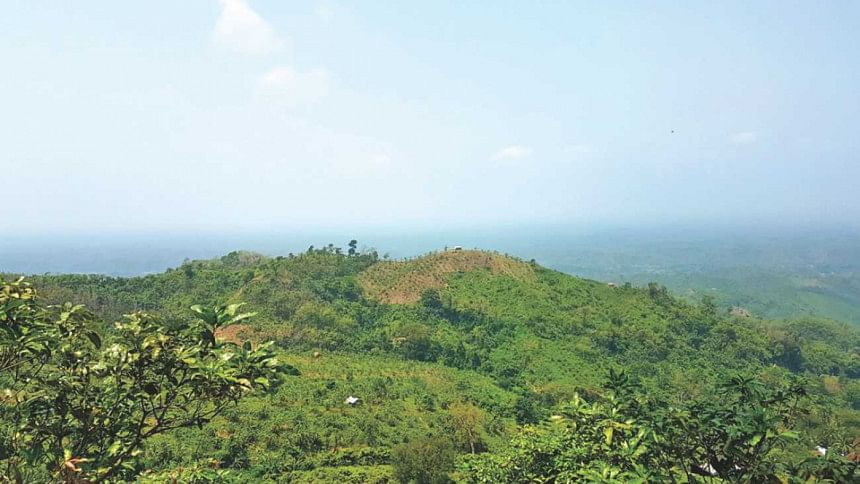
Raja Devashish Roy, in a Facebook note, laid out a detailed strategy including potential short-term, medium-term and long-term intervention for ensuring food security in Sajek. In the short-term, the crisis necessitates adequate relief from the government, and sensitisation of policy makers and international organisations by civil society. In the medium-term, i.e. for the next 2-5 years, food aid support and employment creation (including “Food for Work” schemes) along with access to basic healthcare and safe drinking water should be planned. Moreover, an appropriate socio-economic survey is necessary to know the extent of not only food security needs, but also access to other basic amenities including healthcare, water and education of Sajek dwellers. In the medium to long term, national policies on health, land use, forests, culture, women's development, etc. need to be amended to incorporate the CHT and indigenous contexts and non-discriminatory implementation of laws and policies need to be ensured, he writes.
“I have no magic formulas. But I believe that if what I have identified as the middle term measures are addressed, even in a modest way, long-term solutions will continue to emerge,” he concludes.
Raja Devashish's suggestions were supported by the findings from the consultations carried out by Arun Kanti at Ruilui in Sajek union with villagers and community elders to discuss the current situation. The participants identified rural income generation programme such as 'Food for Work” VGD/VGF, improving infrastructure for better access to market, supplying safe drinking water and ensuring tenure security over land as some of the necessary steps for addressing the food crisis.
However, Chakma is not being able to put his findings to the best use.
“There is very little scope for us to give input in development interventions, although we have worked here for decades,” says Chakma, adding that there was a lack of coordination between government and non-government organisations working in the area.
“Many high officials come here to visit, but do they really see?” he says. “Bangladesh has been declared a middle-income country, but can we really be so without increasing the income and ensuring food security of these people?
If you want to donate, contact:
● Rani Yan Yan: [email protected] (BKash No: 0171 999 4396);
● Boro Rishi Chakma (UZ Chair): +880 182 880 1966;
● Nelson Chakma (UP Chair): +880 186 570 5053).
This report has been supported by Thomson Reuters Foundation, Stanley Foundation and Gerda Henkel Stiftung.
Sohara Mehroze Shachi is a freelance journalist.

 For all latest news, follow The Daily Star's Google News channel.
For all latest news, follow The Daily Star's Google News channel. 


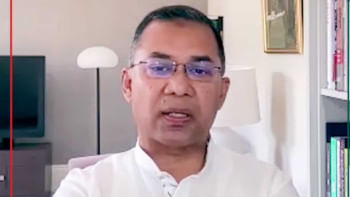
Comments